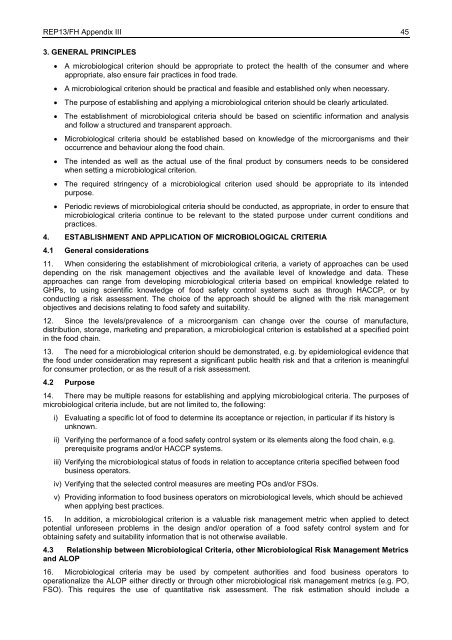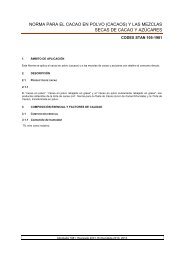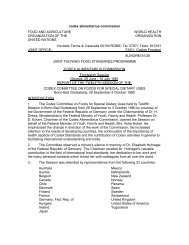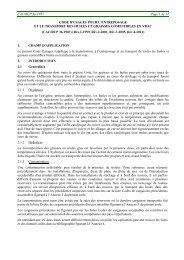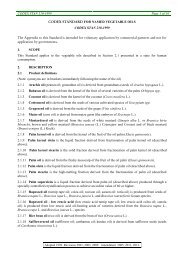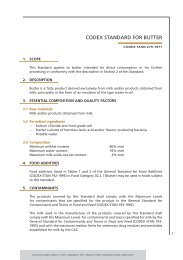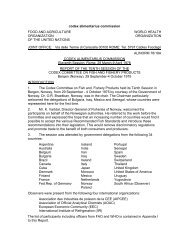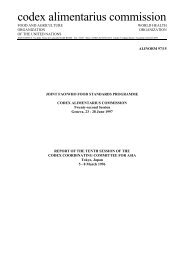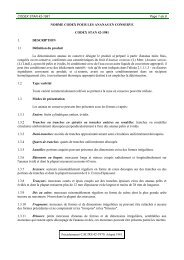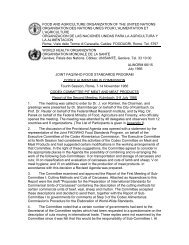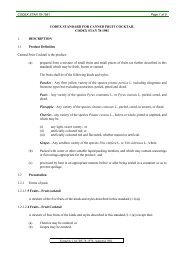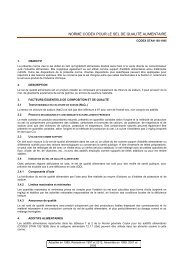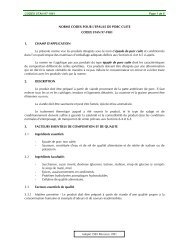REP13/FH JOINT FAO/WHO FOOD STANDARDS PROGRAMME ...
REP13/FH JOINT FAO/WHO FOOD STANDARDS PROGRAMME ...
REP13/FH JOINT FAO/WHO FOOD STANDARDS PROGRAMME ...
You also want an ePaper? Increase the reach of your titles
YUMPU automatically turns print PDFs into web optimized ePapers that Google loves.
<strong>REP13</strong>/<strong>FH</strong> Appendix III 45<br />
3. GENERAL PRINCIPLES<br />
A microbiological criterion should be appropriate to protect the health of the consumer and where<br />
appropriate, also ensure fair practices in food trade.<br />
A microbiological criterion should be practical and feasible and established only when necessary.<br />
The purpose of establishing and applying a microbiological criterion should be clearly articulated.<br />
The establishment of microbiological criteria should be based on scientific information and analysis<br />
and follow a structured and transparent approach.<br />
Microbiological criteria should be established based on knowledge of the microorganisms and their<br />
occurrence and behaviour along the food chain.<br />
The intended as well as the actual use of the final product by consumers needs to be considered<br />
when setting a microbiological criterion.<br />
The required stringency of a microbiological criterion used should be appropriate to its intended<br />
purpose.<br />
Periodic reviews of microbiological criteria should be conducted, as appropriate, in order to ensure that<br />
microbiological criteria continue to be relevant to the stated purpose under current conditions and<br />
practices.<br />
4. ESTABLISHMENT AND APPLICATION OF MICROBIOLOGICAL CRITERIA<br />
4.1 General considerations<br />
11. When considering the establishment of microbiological criteria, a variety of approaches can be used<br />
depending on the risk management objectives and the available level of knowledge and data. These<br />
approaches can range from developing microbiological criteria based on empirical knowledge related to<br />
GHPs, to using scientific knowledge of food safety control systems such as through HACCP, or by<br />
conducting a risk assessment. The choice of the approach should be aligned with the risk management<br />
objectives and decisions relating to food safety and suitability.<br />
12. Since the levels/prevalence of a microorganism can change over the course of manufacture,<br />
distribution, storage, marketing and preparation, a microbiological criterion is established at a specified point<br />
in the food chain.<br />
13. The need for a microbiological criterion should be demonstrated, e.g. by epidemiological evidence that<br />
the food under consideration may represent a significant public health risk and that a criterion is meaningful<br />
for consumer protection, or as the result of a risk assessment.<br />
4.2 Purpose<br />
14. There may be multiple reasons for establishing and applying microbiological criteria. The purposes of<br />
microbiological criteria include, but are not limited to, the following:<br />
i) Evaluating a specific lot of food to determine its acceptance or rejection, in particular if its history is<br />
unknown.<br />
ii) Verifying the performance of a food safety control system or its elements along the food chain, e.g.<br />
prerequisite programs and/or HACCP systems.<br />
iii) Verifying the microbiological status of foods in relation to acceptance criteria specified between food<br />
business operators.<br />
iv) Verifying that the selected control measures are meeting POs and/or FSOs.<br />
v) Providing information to food business operators on microbiological levels, which should be achieved<br />
when applying best practices.<br />
15. In addition, a microbiological criterion is a valuable risk management metric when applied to detect<br />
potential unforeseen problems in the design and/or operation of a food safety control system and for<br />
obtaining safety and suitability information that is not otherwise available.<br />
4.3 Relationship between Microbiological Criteria, other Microbiological Risk Management Metrics<br />
and ALOP<br />
16. Microbiological criteria may be used by competent authorities and food business operators to<br />
operationalize the ALOP either directly or through other microbiological risk management metrics (e.g. PO,<br />
FSO). This requires the use of quantitative risk assessment. The risk estimation should include a


